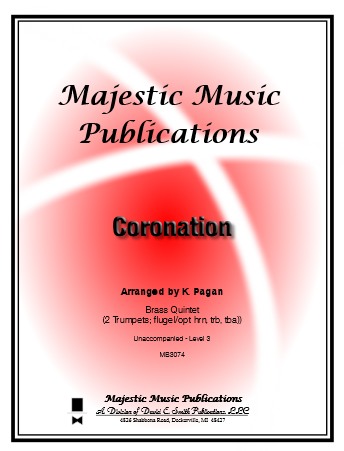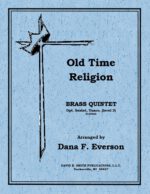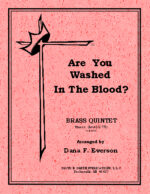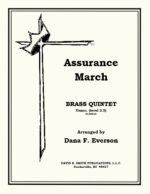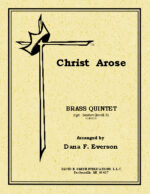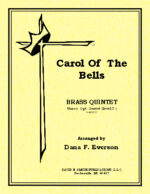| Instrument | |
|---|---|
| Level | 3 |
| Occasion | |
| Theme | Coronation |
| Writer | |
| Publisher | |
| Copyright | 1995 |
| Key | Ab |
| Meter | 4-4, 3-4, 2-4 |
| Idiom | 2 Trp., Hn. (Flugel hn. Sub.), Trb., Tuba |
| Form | Song (binary) All Hail the Power |
Coronation
$14.95
Related products
-
Old Time Religion
$12.00A traditional brass quintet with an optional baritone part which allows to be a sextet as well. The beginning is active establishing a happy beginning to the piece. Then all the parts are in straight harmonies and then become fragmented. A modulation takes place allowing the lower voices to carry the tune. Then a tuba sola solo commences with light upper parts decorating the lines, until the parts fragment. This concludes with a modulation with motivic statements. After a brief intermission the piece takes off again with the tune in the lower voices and the trumpets add a flurry descants. As the piece comes to a close more and more voices add to the mix until the pieces adds a solid, grand statement.
-
-
I Will Sing Of The Mercies
$9.00A woodwind quintet with opt. parts for Alto Sax and Bass Clar. This piece presents itself with a sense of joy throughout with the introduction itself in a motivic manner setting the tone The piece passes through several modulations where the upper voices carry the melodic material while the lower voices support the ensemble with strength. The writing of this arrangement is well crafted to take advantage of the “woodwind quintet sounds.” It continues that way right up to the very end with a declamatory statement of “Mercy.”
-
Meeting In The Air
$12.00A traditional brass quintet with opt. trumpet for horn and extra baritone for use as a sextet. The piece takes off immediately with a thematic statement in the trombone, breaking in a duet with the horn. Additional entries keep massing in the lower voices until most of the ensemble is involved. All of a sudden, the upper brass, silently present the tune in block harmonies until the lower brass present a countermelody. Now! Everybody’s involved. Next, a dialog between the upper brass and middle brass takes place as it alternates back and forth. With a modulation in place the tempo goes slow, the tune is in the lower brass- expressive! All of a sudden from bottom to top motives are presented- in stacked chords…. This goes through different transformations until the piece elevates into an uplifting conclusion.
-
Assurance March
$9.00A traditional brass quintet with opt. trumpet for horn and extra baritone for use as a sextet. A piece in Alle Breve, is simply stated in block chords with an active bass line. The first strain, is repeated, and follows traditional march scoring. The second section is a bit slower and again in block chord structure, but this time with a first trumpet obbligato. With a regaining of tempo and style the piece becomes stronger until a grandiose ending.
-
Christ Arose
$12.00Scored for traditional brass quintet, an optional bartione part can be used to expand the piece to a sextet. After an opening upper brass fanfare, the lower parts present the theme in solemn fashion with further extended fanfares from the upper lines. The middle section reverses the stylistic assignments only to be given back to the opening styles. The with a powerful stacking of parts the piece concludes in a triumphant chord.
-
Carol Of The Bells
$12.00A traditional quintet with optional sixth part baritone, this driving arrangement passes the melodic material constantly around the ensemble. A fun piece to play!
-

